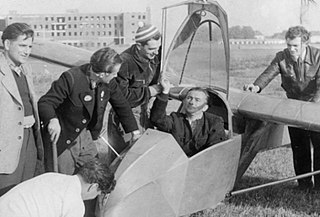
The CVV-4 Pellicano was a single seat Italian glider designed for a competition to select an aircraft for the 1940 Olympic Games. The DFS Olympia Meise was preferred to it after the trials in Italy in 1939.

The Ciani EC 38/56 Urendo, or SSVV EC 38/56 Urendo is an Italian tandem-seat training glider from the 1950s. Four were built, one winning the Italian National Championships in 1959. Another, restored, still flies.

The Bonomi BS.7 Allievo Italia was a single seat, primary glider designed and built in Italy in the 1920s.
The Bonomi BS.14 Astore was a two-seat training and aerobatic glider, designed and built in Italy in 1935. Only one was constructed.
The Bonomi BS.16 Allievo Bonomi was a single seat primary glider, designed and built in Italy in 1930 and widely used by flying clubs.
The Bonomi BS.18 Airone was a single seat training glider, designed in Italy in 1936. Only one was built.
The Bonomi BS.24 Biposto Rome was an Italian dual control trainer designed for club use. Six were built in the mid-1930s.
The Bonomi BS.28 Alcione, sometimes known as the Lombarda BS.28 Alcione, was a single seat competition sailplane designed and built in Italy in 1937-8. About four were completed, with two more or less refined fuselages.
The CAT 15 was a single-seat primary glider built in Italy just before the Second World War. Only one was constructed.
The Sala N1 or N1 Sala was a single-seat,18 m span competition glider built in Italy in 1933. Only one was constructed.
The Romeo Ro.35, a.k.a.IMAM Ro.35 was a single-seat glider built in Italy in 1933.
The Teichfuss Gabbiano was an Italian, one-off, single seat, high performance glider, designed by Luigi Teichfuss and flown in 1928.
The Teichfuss Cicogna was an Italian tailless single-seat motor glider designed by Luigi Teichfuss and flown in 1936.
The Teichfuss Astore was an Italian Intermediate single-seat trainer glider designed by Luigi Teichfuss and flown in 1936. Two were built.
The CAT 28BP was an Italian development of the licence built Dittmar Condor II into a high performance tandem two seat glider. Built in 1938, it anticipated the post-war, two seat Dittmar Condor IV and held the Italian national distance record for many years.

The Scheibe Specht is a tandem seat training glider produced in Germany in the early 1950s. More than fifty were built.

The Oberlerchner Mg 19 Steinadler is an Erwin Musger designed two seat tandem trainer glider built in Austria and first flown in 1951. Several examples of this successful aircraft, which competed in the two seat class at two World Gliding Championships in the 1950s, were still flying in 2000.
The Spalinger S.18 is a Swiss 1930s performance sailplane. Several variants were built and the S.18 dominated Swiss contests and set records for nearly a decade. Many were active into the 1960s and four remain on the Swiss register.
The Spalinger S.25 is a 1940s development of the S.21 two seat trainer with much improved visibility from the rear seat. Three examples were completed, each different to the others.

The Spalinger S.15 is a Swiss, single-seat training glider first flown in 1930. There were several variants, of which only the 1934 S.15K was serially produced. One restored example remains active in 2019.






